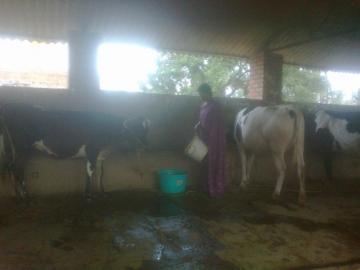
Introduction:
“It is not possible for a bird to fly on only one wing –Swami Vivekananda”
India is a male dominated state, where women empowerment seems to be highly a question mark. The very concept of women empowerment shows that society as such has given a raw deal to women-Who comprise nearly fifty percent of the population and women themselves have to come forward to fight for their rightful place in all walks of life and prevent their exploitation in every field. In this case study you can find a woman who seems to be come forward to face the challenges in all her walks of life through dairy farming.
Objectives of the case study:
· Study is to identify the effective woman dairy farmers as a model.
· To empower women economically and socially.
· To understand the interest of woman in dairy farming.
Designing of the case study:
Case study has four various types where in here exploratory (pilot) case study has been done as an initial findings seems to be effective.
Participant Selection:
In this case study one participant has been identified based on the interaction, interest shown in the training programme and observation done by the researcher.
Methodology of the case study:
Observation, interviews, references and direct interaction are the methodology followed in this case study.
Case study:
Name: Nirmala.K
Husband Name: Ramakrishna Reddy
Daughter Name: Swathi Reddy
Son Name: Naveen Reddy
Nirmala aged about 40 born in Tamilnadu, a middle class family and studied up to S.S.L.C. Since her childhood she is interested in agriculture and its allied activities as well as she is self-motivated and also taught about self-respect and self-sustainability by her parents. In the year 1986 she was got married to Ramakrishna Reddy and came to Kolar district with a cow as a dowry. She brought jersey breed which used to give 13-14 litres of milk per day. She decided to be self-reliant and doesn’t want to depend on her husband’s family for her own needs. That made her to look after her animal properly and she used to pour nearly 10 litres of milk per day in the nearby cooperative society which is two kilometres away from her village. Per litre seven rupees fifty paisa is the amount fixed by the society to its milk pourers which seems to be a handful of income for her.
Later she found difficult to take care of her animal due to her household works and she need to spend more time to take care of her children’s, which ultimately resulted in reduce in supply of milk to the society. But she hadn’t given up she tried to find a way to come across her barriers. In the year 2000 with the support of Central Government scheme Swa-Sakthi SHG group has been formed in her village in which she became a member and attended different trainings based on dairy farming. On the other hand agriculture doesn’t seem to be a regular income to their family due to drought and improper seasonal rainfall in their area. In 2004 she attended a 5 day training programme at Farmers Training Institute, Bangalore, where she learnt about the importance of animal care and management. Due to those trainings she got boosted up once again and started focusing on her animal. By using her saving she purchased another five more cows to solve the financial crises of their family. On those days she used to pour nearly 60 litres per day in the nearby cooperative society.
In the year 2005 she sold two cows for Rs.40000 to pay her daughters first year M.C.A course fees. On that day she realised the importance and value of the cow she brought from her parents’ home as dowry. Utilising the other cows and taking proper care on them she purchased another 4 through bank loans. Later her husband also joined with her in rearing animals which motivated her mentally. Since her health is not supporting her properly she is forced to appoint labours in their dairy farm. Due to heavy labour cost she suffered in getting regular labour to look after their animals this ultimately forced her to sell another two animals. She decided to take care of the animals by her own, with the availability of fodder in her land she used to feed those animals properly. She said that comparing her production cost income in dairying seems to be quite sustainable, regular and profitable. She is also quite happy with the support extended by the Govt. of Karnataka for providing Rs.2 per litre.
Conclusion:
Out of her expenses and repayment of loan she is saving 25000 every year through dairy farming. She explains proudly that I am not dependent on my husband or with my children. I earn with my own effort and no one in my family opposes me. I have been given enough support by my family members because of the sustainable income from dairying.
